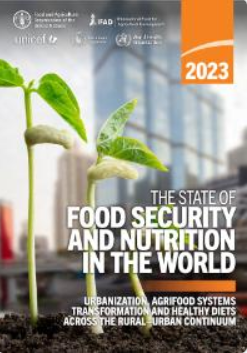Report: The State of Food Security and Nutrition in the World in 2023

FAO, IFAD, UNICEF, WFP and WHO have recently published a report sharing the information on the global advancement of the SDGs target 2.1, ending hunger, and 2.2, ending all forms of malnutrition.
The report refers to hunger as both the painful sensation caused by not eating enough food and the inability to obtain food in the face of hunger, but also as food insecurity, the uncertainty to know for how long food will last or be available.
To measure hunger, FAO uses the Prevalence of Undernourishment (PoU) indicator: it measures how many people do not have regular access to enough calories, or dietary energy, for an active and healthy life. In 2022 about 735 million people faced hunger. On the other hand, to measure food insecurity, FAO uses the Food Insecurity Experience Scale (FIES), which estimates the different levels of insecurity. There are 2.4 billion people who are either moderately or severely food insecure in the world.
Both lhunger and food insecurity remained mostly unchanged in the period 2021-2022, but they are still far above pre-COVID-19-pandemic levels. Almost 600 million people are projected to be chronically undernourished in 2030.
This year’s report highlights a series of relevant megatrends, most specifically, urbanization. Data suggests that food purchasing is increasing in rural households and that peri-urban and rural areas have seen a rise in the consumption of highly processed foods. Consequently, the level of food security and nutrition depends on where people live across the rural-urban continuum.
In line with the New Urban Agenda, the report delivers recommendations on how to manage the issue of agrifood systems transformation under urbanization and how to create opportunities to guarantee universal access to inexpensive healthy food, mainly through policies, actions and investments.

